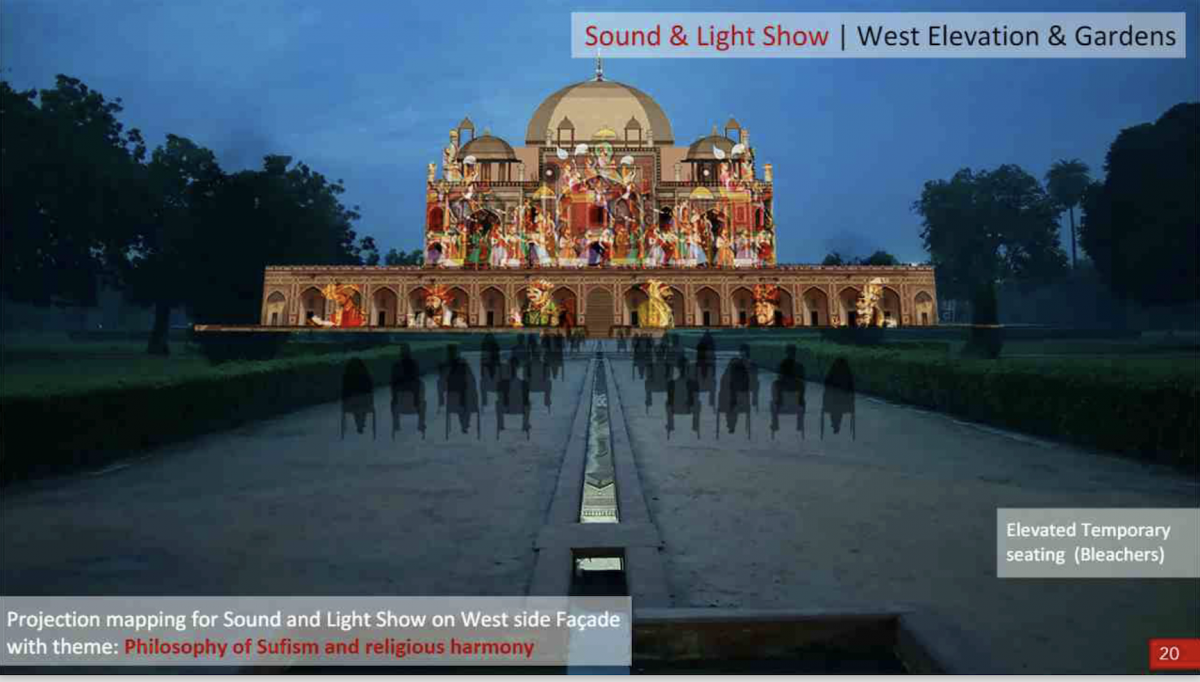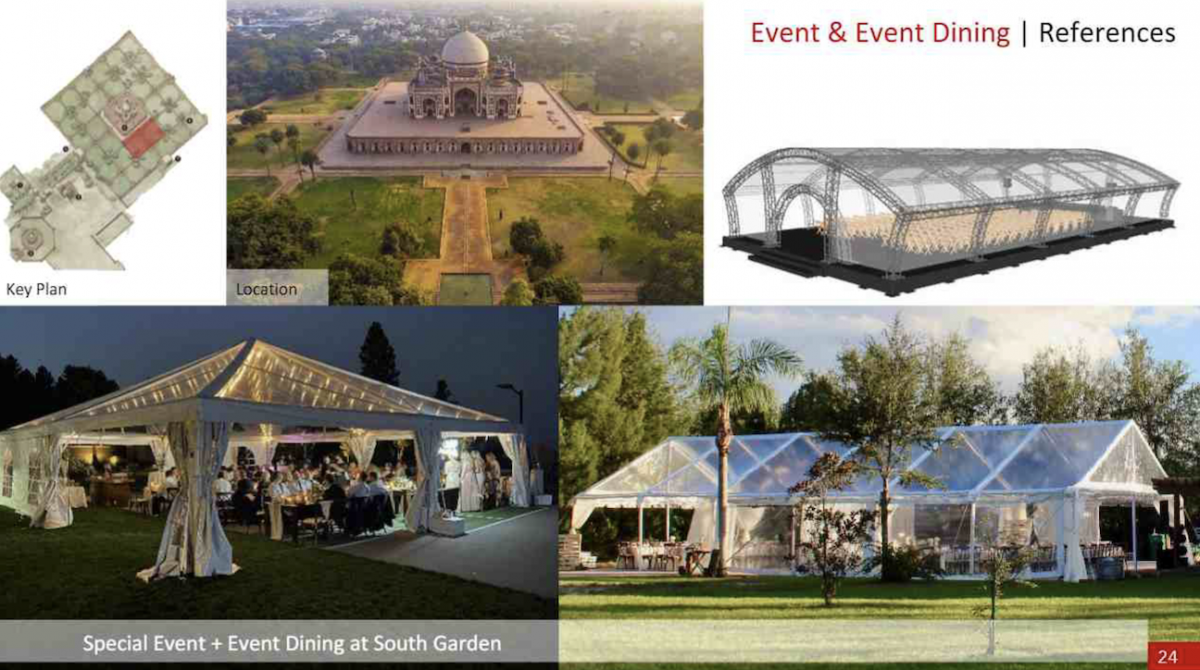Conserving India's Heritage, Modi Style: 'Adopt' a Monument, and Build a Restaurant in It
New Delhi: A ‘fine-dining restaurant’ inside the southern gateway of Humayun’s Tomb is one of many plans for the monument’s makeover under the Ministry of Culture’s “Adopt a Heritage” scheme that has conservation experts up in arms.
Besides the restaurant, the ‘vision document’ of the corporate group entrusted with ‘adopting’ the 16th century complex – a UNESCO World Heritage Site – also proposes a café atop the western entry gate. The restaurant and the café will be accessed by elevators installed abutting the historical structures. And there’s more: a gaudy sound and light show on the tomb’s western façade; and special events and private dining in the gardens.
These changes to Humayun’s Tomb have been entrusted to the Dalmia Bharat group, which also controversially “adopted” the Red Fort in 2018. Similar proposals have been made for Safdarjung’s Tomb, Purana Qila and the Mehrauli Archaeological Park.
When Dalmia Bharat, a cement company with little experience in conservation, came forward to “adopt” the Red Fort in 2018, its CEO Mahendra Singhi said, “It will help us integrate the Dalmia brand with India.” The founder of the group, the late Vishnu Hari Dalmia, was a former president of the Vishwa Hindu Parishad and an accused in the Babri Masjid demolition case.
In March 2024, the group signed a new MoU with the Archaeological Survey of India (ASI). The MoU covers Humayun’s Tomb, but also the Purana Qila, Safdarjung’s Tomb, and the Mehrauli Archaeological Park, which will all be managed by a Dalmia Bharat offshoot, the Sabhyata Foundation.
The ASI has signed 19 MoUs with corporate entities, covering 66 monuments across the country, including the Qutub Minar, the Elephanta Caves, and the Sun Temple of Konark. Of these entities, only the Dalmia group has been allowed to plan commercial construction and activity around the monuments, said ASI officials, who did not wish to be quoted.
According to the Sabhyata Foundation’s vision document, it wants visitors to "experience the narrative of Soft Islam (sic), Sufi Philosophy and Religious Harmony". Among various themed events it has lined up are shows on on Humayun's astronomical endeavours, the "role of Rajput women in Mughal empire" and "Tales of Horses and Elephants in the Rajput-Mughal History of India". To improve the view of the sound and light show it is planning, it says trees in the Humayun’s Tomb complex will be “relocated”.

View of the proposed sound-and-light-show. Source: Sabhyata Foundation 'vision document' for Humayun's Tomb
Incidentally, the complex received its World Heritage Status on account of not just the tomb, but its char-bagh garden, the earliest of its kind in India (which later inspired the Taj Mahal).
Also on the anvil: "calendarized events with dining (curated experiences and cuisine as per theme)" as well as fashion shows.
ASI officials had objected that such events and shows at a World Heritage monument were inappropriate, but were ignored.

View of proposed event and event dining. Source: Sabhyata Foundation 'vision document' for Humayun's Tomb
Historians and archaeologists are aghast at the plans. “This is in complete violation of the spirit of the place,” said Narayani Gupta, former professor at Jamia Millia Islamia University.
“Humayun’s tomb is a memorial to the dead,” she said. “Can we have dancing and singing and dining at the National War Memorial [at India Gate]? This is vulgarising the place. A small café like at Sundar Nursery would have sufficed.”
Humayun’s Tomb is home to 130 graves.
The Ancient Monuments Act, 1958 sets rigorous rules to protect heritage monuments from damage of various kinds and the ASI has been especially touchy about any cooking of food in the premises of a protected monument.
“The mortar used in Mughal monuments comprises at least 27 ingredients, including dal and jaggery,” said a source in the ASI. “Organisms will feed on the waste generated and then start attacking the mortar. Add to that, waste water and construction for the restaurant and the lift. That will all weaken the monument.”
In its literature, the Sabhyata Foundation has sought to draw parallels with the Acropolis in Athens and the Pyramids of Giza to justify their planned restaurants. But the reference images in the group’s ‘vision document’ show restaurants at a distance from those monuments, with a view of them; quite unlike the proposal to install restaurants inside and atop parts of the historical structures of the Humayun's Tomb complex.
ASI spokesperson T.J. Alone told The Wire, “Mainly CSR funds will be used for the scheme to provide facilities to the public. Some facilities such as tickets, parking and sound and light shows are chargeable but that is only to regulate visitors.”
The spokesperson said he was not aware of what Sabhyata Foundation was planning at the sites. He asked for a list of questions to be sent but is yet to respond.
At the Purana Qila, the 16-century fort built during Humayun’s reign, a sound and light show dedicated to tales from the Mahabharat was inaugurated on March 31 by external affairs minister S. Jaishankar. The minister was clear in his intentions when he said, "Today the battle is for culture rebalancing. How do we recognise the entire diversity of the world, how do we undo the distortions of an era which was distorted by a few countries and a few regions… That is why it is crucial today to project our own heritage, our culture, our way of life, our faith, our belief.”
At the Red Fort, the only museum dedicated to Mughal history, housed in Mumtaz Mahal, was shut post-2018 and hasn’t been reopened. Officials say they plan to reopen it but don’t know when.
“It is absurd to eliminate the Mughals from the Red Fort. It is crude and makes the government look silly,” says a heritage expert, who asked to remain anonymous. “In fact, there appears to be a determined effort to withdraw the Mughals outside the history of Delhi from our museums. The display of Mughal miniatures is getting smaller by the day at the National Museum. But while you can wipe out history from the museums, the entire spectrum of Indo-Islamic history is on display across the city through its monuments.”
The initial idea of “adopting” monuments was about directing CSR (corporate social responsibility) funds to government bodies like the ASI. The corporate donor would simply choose which monument to sponsor. A Rs 50-crore corpus was earmarked for the national culture fund. Revenue was never the aim.
“The sound and light show at the Red Fort now costs Rs 1500,” said a source in the ASI. “Can a family of four afford that? The public has a sentimental attachment to the Red Fort. Should there be segregation of those who can afford it and those who can’t?”
Questions are also being raised about the legal validity of the scheme. The Ancient Monuments Act, 1958, empowers the DG, ASI to receive voluntary contributions. Here, no funds are being given for the scheme. This a privatised business model, says an official. “The CSR model has been changed to a business model, which is also a violation of the Ancient Monuments and Archaeological Sites and Remains Act, 1958,” he said. “And it is only for the Dalmia group that the scheme has been made semi-commercial.”
The MoU contains no mention of a restaurant, though there is a provision for a café. In the past, the ASI has insisted that only packaged food be sold cafes at protected monuments.
Avantika Dalmia, co-chair of the advisory board of Sabhyata Foundation, asked for a list of questions to be sent to her colleague. She has not responded, and this story will be updated if she does.
This article went live on September twenty-ninth, two thousand twenty four, at twenty-eight minutes past three in the afternoon.The Wire is now on WhatsApp. Follow our channel for sharp analysis and opinions on the latest developments.




